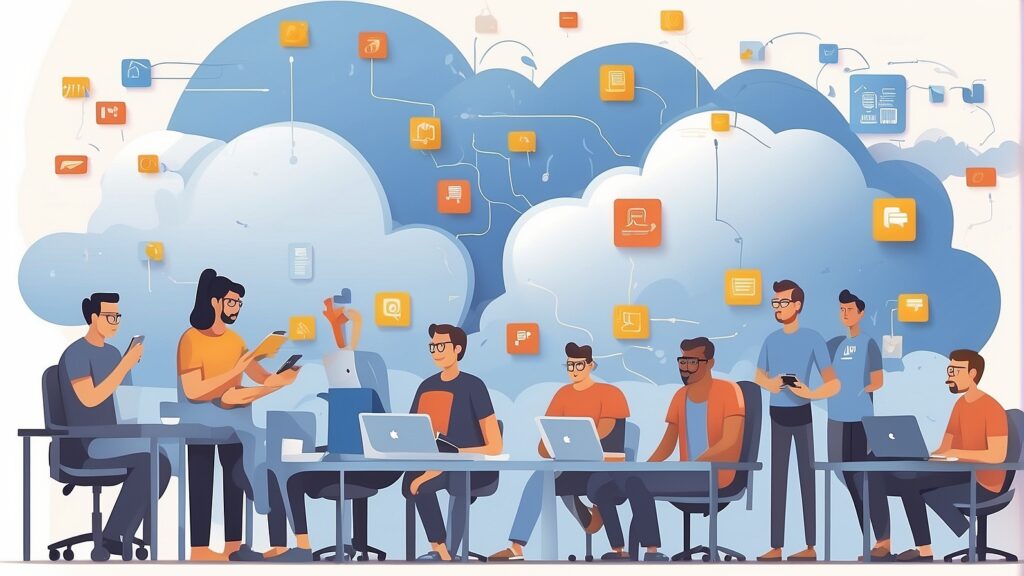Key Takeaways
- Maximizing Productivity in Remote Team Meetings: Effective strategies and tools for streamlined communication.
- Choosing the Right Tools: Criteria for selecting the best meeting software tailored to team needs.
- Engagement Techniques: Tactics to keep team members involved and attentive.
- Managing Time Zones and Schedules: Best practices for accommodating global teams.
- Handling Technical Issues: Preparing for and addressing common technical challenges.
The shift to remote work has revolutionized how we conduct team meetings. Gone are the days of crowded conference rooms; today, digital platforms have become the norm.
This shift, while offering flexibility, also brings its challenges. Effective remote team meetings require a blend of the right tools, tactics, and an understanding of the nuances of virtual communication.
Here, we delve into how to make your remote team meetings more effective, covering everything from choosing the right tools to managing time zones.

Choosing the Right Tools for Remote Team Meetings
Selecting the right software is crucial for effective remote team meetings. The market is saturated with options, each boasting unique features. When choosing, consider the following:
Ease of Use and Accessibility
The tool should be user-friendly, with a simple interface accessible to all team members, regardless of their technical skills. It should work seamlessly on various devices and operating systems.
Features That Match Your Team’s Needs
List the features your team needs: video conferencing, screen sharing, recording options, chat functionality, and integration with other tools. Prioritize these when comparing different platforms.
Security and Privacy
Given the sensitive nature of business discussions, ensure the tool provides end-to-end encryption and complies with data privacy laws.
Scalability and Reliability
Choose a tool that can support the size of your team and doesn’t lag or crash during large meetings. Check for uptime statistics and user reviews to gauge reliability.
Pricing and Budget
Compare the cost against the features offered. Some tools offer free versions with basic features, which might be sufficient for small teams or startups.
Engaging Remote Teams in Meetings
Engagement in remote meetings can be challenging. Here’s how to keep your team members active and interested:
Setting Clear Agendas
Send out a clear agenda before the meeting. It helps team members prepare and ensures the meeting stays on track.
Interactive Elements
Use interactive elements like polls, quizzes, and Q&A sessions. These tools can break the monotony and encourage participation.
Regular Breaks
For longer meetings, schedule short breaks. It helps participants stay focused and refreshed.
Encouraging Participation
Create an inclusive atmosphere where everyone feels comfortable sharing their thoughts. Address team members by name and invite input from quieter members.
Using Visual Aids
Visual aids like slides, charts, and videos can make presentations more engaging and easier to follow.
Managing Time Zones and Schedules
With remote teams often spread across the globe, scheduling meetings can be complex.
Find a Common Time
Use tools like World Time Buddy to find overlapping working hours. Aim to rotate meeting times if no single time works for everyone.
Advance Scheduling
Schedule meetings well in advance and consider using scheduling tools like Doodle to find the most suitable time slots.
Recording Meetings
For team members who can’t attend due to time zone differences, record meetings and share them along with a brief summary.
Effective Communication in Remote Meetings
Communication in remote meetings requires a different approach than in-person interactions.
Clear and Concise Communication
Be clear and concise. Remote meetings are not the place for long-winded speeches.
Active Listening
Encourage active listening. Remind participants to mute their microphones when not speaking to minimize background noise.
Non-Verbal Cues
Pay attention to non-verbal cues. In a virtual environment, understanding body language and facial expressions is key to gauging reactions and emotions.
Follow-Up Communications
After the meeting, send a follow-up email summarizing the discussion points and action items.
Handling Technical Issues in Remote Meetings
Technical issues are inevitable in remote meetings. Here’s how to handle them:
Prior Testing of Equipment
Encourage team members to test their equipment before the meeting. This includes their internet connection, microphone, camera, and the meeting software.
Having a Backup Plan
Have a backup plan in case the primary tool fails. This could be an alternative meeting platform or a phone call.
Training and Support
Provide training and support for team members who are not tech-savvy. This could include tutorials or a dedicated IT support contact.
Patience and Flexibility
Technical issues can be frustrating. Maintain a culture of patience and flexibility when they occur. It’s important to remember that everyone is adapting to this new way of working.

Cultivating Team Culture in Virtual Meetings
Fostering a strong team culture in a remote environment can be challenging but is essential for a cohesive and productive team.
Regular Check-ins
Start meetings with personal check-ins or icebreakers. This builds rapport and gives a sense of inclusion.
Celebrating Milestones
Acknowledge team and individual achievements. Celebrate work anniversaries, project completions, or personal milestones within the team.
Virtual Team Building Activities
Organize virtual team-building activities. This could be a casual coffee chat, a virtual game session, or a skill-sharing workshop.
Encouraging Informal Communication
Create virtual spaces for informal chats and non-work-related discussions. This could be a dedicated channel on communication platforms like Slack or Microsoft Teams.
Recognizing and Respecting Cultural Differences
Be aware of and respect the cultural differences within your team. This includes understanding different communication styles and holidays.
Structuring Meetings for Maximum Efficiency
A well-structured meeting can greatly enhance productivity and ensure that time is used effectively.
Timeboxing
Allocate specific time slots for each agenda item. This keeps the meeting on track and ensures all topics are covered.
Assigning Roles
Assign roles such as a facilitator, note-taker, and timekeeper for each meeting. This helps in organizing and streamlining the meeting process.
Using Collaborative Documents
Use collaborative documents for real-time note-taking and sharing of resources. Tools like Google Docs or Microsoft OneDrive can be effective.
Prioritizing Agenda Items
Prioritize agenda items based on urgency and importance. Tackle critical issues first when participants are most alert.
Post-Meeting Action Items
End each meeting with a summary of action items. Assign clear responsibilities and deadlines for follow-up tasks.
Leveraging Asynchronous Communication
Not all team communication needs to happen in real-time. Asynchronous communication can be a powerful tool in remote settings.
Defining Asynchronous Channels
Establish channels for asynchronous communication, such as email, project management tools, or dedicated messaging boards.
Clarity and Detail in Communication
Ensure that asynchronous messages are clear and detailed to minimize back-and-forth clarification.
Setting Response Time Expectations
Set clear expectations regarding response times for different types of asynchronous communication.
Recording Video Updates
For complex updates, consider recording short video messages. This can be more personal and clearer than written communication.
Using Asynchronous Tools for Brainstorming
Leverage tools like Trello or Miro for asynchronous brainstorming and idea gathering.
Optimizing Remote Meeting Technologies
Beyond choosing the right tool, optimizing the use of these technologies can enhance the meeting experience.
Advanced Features of Meeting Tools
Explore and utilize advanced features of your meeting tools like breakout rooms, whiteboards, or polling.
Integrations with Other Tools
Integrate your meeting tools with other software used by your team, like calendars, project management apps, or CRM systems.
Customizing Meeting Settings
Customize meeting settings for your team’s needs – like enabling waiting rooms, custom backgrounds, or recording options.
Updating and Maintaining Software
Regularly update meeting software to access new features and security updates. Ensure all team members do the same.
Providing Training on New Features
When new features or tools are introduced, provide training sessions or resources to ensure everyone can use them effectively.

Creating Inclusive Remote Meetings
Inclusivity in remote meetings ensures that every team member feels valued and heard.
Providing Multiple Ways to Contribute
Offer various ways for participants to contribute, such as speaking, typing in chat, or using reaction emojis.
Language and Communication Style
Use inclusive language and be mindful of varying communication styles and language proficiencies.
Accessibility Considerations
Ensure meetings are accessible to all team members, including those with disabilities. This may involve captioning, screen reader compatibility, and more.
Inclusive Scheduling
Be mindful of scheduling meetings at times that are inclusive of all team members’ time zones and work-life balance.
Seeking Feedback
Regularly seek feedback from team members on how to make meetings more inclusive and address any concerns raised.
Advanced Meeting Preparation Techniques
Effective remote team meetings begin long before the actual meeting. Advanced preparation can set the stage for a successful and productive session.
Pre-Meeting Surveys and Feedback
Gather input from team members on agenda items or discussion points through pre-meeting surveys. Tools like Google Forms or SurveyMonkey can facilitate this process.
Distributing Pre-Reading Materials
Ensure all participants have access to necessary background information or reading materials well in advance. This enables them to come prepared and contributes to a more informed discussion.
Setting Clear Expectations
Communicate the goals of the meeting clearly to all participants. This includes what is expected from each team member, the objectives of the meeting, and the desired outcomes.
Preparing Visual Aids and Presentations
Design and distribute any visual aids or presentations beforehand. This allows team members to familiarize themselves with the content, leading to more effective discussions.
Tech Check and Troubleshooting
Encourage participants to perform a tech check before the meeting. This includes testing their internet connection, audio, and video equipment to avoid delays due to technical issues.
Dynamic Meeting Facilitation
The role of a facilitator is crucial in remote meetings. A dynamic facilitator can keep the meeting engaging and ensure that objectives are met.
Active Facilitation Techniques
Utilize active facilitation techniques such as prompting quiet members, steering conversations back on track, and summarizing key points.
Managing Diverse Perspectives
Encourage diverse viewpoints and manage conflicts that may arise during discussions. A good facilitator knows how to balance different opinions and steer the conversation constructively.
Utilizing Breakout Rooms
For larger meetings, use breakout rooms to facilitate smaller group discussions. This can lead to more in-depth discussions and increased participation.
Time Management
Keep a strict watch on the time allocated for each agenda item. The facilitator should intervene when discussions go off track or when time limits are exceeded.
Post-Meeting Feedback
Gather feedback on the meeting’s effectiveness from participants. This can help improve future meetings.
Strategies for Large-Scale Remote Meetings
Handling large-scale remote meetings presents its own set of challenges. Here are strategies to manage them effectively.
Structuring for Large Groups
Structure the meeting to accommodate the large number of participants. This might include having a more formal agenda and stricter time management.
Role Delegation
Assign specific roles, such as moderators or note-takers, to manage different aspects of the meeting. This ensures that the meeting runs smoothly and that all important points are captured.
Utilizing Robust Meeting Platforms
Choose a meeting platform that can handle a large number of participants without compromising on quality. Platforms like Zoom or Microsoft Teams are often suitable for such meetings.
Encouraging Active Participation
In large meetings, it’s easy for participants to become passive. Encourage active participation by calling on individuals or using interactive tools like polls or quizzes.
Recording and Documentation
Record large meetings for those who cannot attend or for future reference. Ensure that detailed minutes are taken and distributed post-meeting.
Hybrid Meetings: Combining Remote and In-Person Elements
As workplaces evolve, hybrid meetings, where some team members are in-person and others are remote, are becoming more common.
Ensuring Equal Participation
Make sure that both remote and in-person participants can contribute equally. This includes having the necessary technology in place to facilitate this.
Audio and Video Quality
Invest in quality audio and video equipment to ensure that remote participants can hear and see the in-person group clearly, and vice versa.
Integrating Virtual and Physical Spaces
Use tools and techniques to integrate virtual and physical meeting spaces. This could include using a digital whiteboard that both remote and in-person team members can interact with.

Managing Dynamics
Be aware of the dynamics between remote and in-person participants. Facilitators should ensure that one group is not dominating the conversation over the other.
Feedback Loop
Establish a feedback loop to continuously improve the hybrid meeting experience. This feedback should come from both remote and in-person participants.
Continuously Improving Meeting Effectiveness
To ensure the long-term success of remote meetings, it’s important to focus on continuous improvement.
Regular Review of Tools and Processes
Regularly review and update the tools and processes used for remote meetings. This includes staying updated on new features or tools available.
Training and Development
Provide ongoing training and development opportunities for team members to improve their remote communication and collaboration skills.
Measuring Meeting Effectiveness
Use metrics and KPIs to measure the effectiveness of meetings. This could include participant engagement, meeting objectives achieved, and post-meeting feedback.
Iterative Improvement
Adopt an iterative approach to improving meetings. Implement changes based on feedback and monitor their impact over time.
Leveraging Technology
Continuously explore new technological solutions that can enhance the remote meeting experience, such as AI-driven analytics or advanced collaboration tools.
Mastering the Art of Follow-Ups in Remote Meetings
Effective follow-ups are crucial in ensuring that the decisions and action items from remote meetings are executed properly.
Structuring Follow-Up Communications
Craft follow-up communications that are clear and concise. Summarize key decisions, assigned tasks, and respective deadlines. Utilize email, project management tools, or collaboration platforms for this purpose.
Setting Clear Deadlines and Expectations
Assign clear deadlines for each action item and communicate expectations for their completion. This avoids ambiguity and ensures accountability.
Regular Progress Checks
Schedule regular check-ins to monitor the progress of tasks. This can be done through brief stand-up meetings or update threads in project management tools.
Providing Support and Resources
Ensure that team members have the necessary support and resources to complete their tasks. This might involve additional training, access to specific tools, or assistance from other team members.
Documenting and Archiving Decisions
Maintain a centralized repository for meeting minutes and decisions. This ensures that there is a single source of truth that team members can refer to when needed.
Balancing Synchronous and Asynchronous Communication
Finding the right balance between synchronous (real-time) and asynchronous communication is key to efficient remote team collaboration.
Understanding the Role of Each Communication Type
Recognize when to use synchronous communication (e.g., decision-making, brainstorming sessions) and when to rely on asynchronous methods (e.g., progress updates, feedback collection).
Encouraging Asynchronous Workflows
Encourage the use of asynchronous communication for tasks that don’t require immediate responses. This respects the varying schedules of remote team members and can lead to more thoughtful, well-articulated responses.
Setting Boundaries and Expectations
Establish clear guidelines on response times for asynchronous communications. This helps in managing expectations and reduces the pressure to be always available.
Using the Right Tools for Asynchronous Communication
Leverage tools like Slack for instant messaging, Trello for task management, and Confluence for documentation. Choose tools that best suit the nature of the communication and the preferences of the team.
Integrating Asynchronous Methods into Meetings
Incorporate asynchronous elements into meetings, such as pre-meeting questionnaires or post-meeting feedback forms, to enhance participation and gather diverse inputs.
Navigating Time Zone Challenges in Global Teams
For teams spread across multiple time zones, managing meetings can be particularly challenging.
Rotating Meeting Times
Implement a rotating schedule for meetings to distribute the inconvenience of odd hours more evenly among team members.
Recording Meetings for Later Viewing
Always record meetings and make them available for team members who cannot attend in real time. Accompany the recordings with detailed minutes to facilitate easy catching up.
Using Time Zone Management Tools
Utilize time zone management tools like Time Zone Converter or World Clock to schedule meetings at the most convenient times for the majority.
Asynchronous Decision Making
Where possible, shift decision-making processes to asynchronous platforms. This allows team members in different time zones to contribute at their convenience.
Respect and Empathy
Foster a culture of respect and empathy for team members in less convenient time zones. Acknowledge the challenges they face and appreciate their efforts to participate.

Leveraging Data and Analytics for Meeting Improvement
Data and analytics can provide valuable insights into the effectiveness of remote meetings.
Analyzing Participation and Engagement
Use meeting analytics tools to track participation rates, engagement levels, and patterns in communication. This data can help identify areas for improvement.
Gathering Feedback through Surveys
Regularly conduct surveys to gather feedback on the meeting experience from team members. Analyze this feedback to make data-driven improvements.
Monitoring Meeting Duration and Frequency
Track the duration and frequency of meetings to ensure they are optimized for productivity. Excessive or overly lengthy meetings can lead to fatigue and decreased engagement.
Analyzing Task Completion Rates
Review the completion rates of tasks assigned during meetings. This can provide insights into the clarity and feasibility of the action items.
Continuous Improvement Through Data
Adopt a continuous improvement mindset, using data and analytics as a guide to refine meeting strategies and techniques.
Cultivating Emotional Intelligence in Remote Meetings
Emotional intelligence plays a crucial role in the success of remote meetings, impacting communication, collaboration, and team morale.
Recognizing and Addressing Emotional Cues
Train team leaders and members to recognize emotional cues, even in a virtual environment. This includes paying attention to tone of voice, facial expressions, and engagement levels.
Creating a Safe Space for Sharing
Foster an environment where team members feel safe to express their thoughts and emotions. This can be achieved through empathetic leadership and a culture of openness and respect.
Empathetic Leadership
Encourage leaders to demonstrate empathy, actively listen to team member concerns, and provide support where needed.
Building Trust and Rapport
Invest time in building trust and rapport among team members. This can be facilitated through regular informal interactions and open communication channels.
Training on Emotional Intelligence
Provide training and resources to help team members develop their emotional intelligence skills. This can enhance understanding, collaboration, and overall team dynamics.
Table: Comparison of Popular Remote Meeting Tools
| Feature | Zoom | Microsoft Teams | Google Meet | Slack |
|---|---|---|---|---|
| Video Quality | High | Moderate-High | High | Moderate |
| Maximum Participants | 100 (Free), 500 (Paid) | 300 | 100 (Free), 250 (Paid) | 15 |
| Screen Sharing | Yes | Yes | Yes | Yes |
| Recording | Yes (Paid) | Yes | Yes (Paid) | No |
| Integration | Wide range, including Slack, Trello | Office 365, OneDrive | Google Workspace | Google Drive, Trello, Asana |
| Chat Feature | Yes | Yes | Yes | Yes |
| Security | End-to-end encryption | Advanced security compliance | Secure encryption | Secure encryption |
| Unique Feature | Breakout rooms, virtual backgrounds | Seamless integration with Office 365 tools | Easy access via Google account | Seamless integration within communication platform |
This table provides a snapshot of key features of popular remote meeting tools, helping teams make an informed choice based on their specific needs.
Conclusion
Effective remote team meetings are a cornerstone of successful remote work. By selecting the right tools, fostering a strong team culture, structuring meetings efficiently, and balancing various communication forms, teams can overcome the challenges posed by distance.
The nuances of managing diverse, global teams require a thoughtful approach to scheduling and communication, underpinned by a strong foundation in emotional intelligence and data-driven strategies. As remote work continues to evolve, mastering the art of remote meetings will remain a critical skill for teams and organizations worldwide.
Frequently Asked Questions
How can remote meetings be made more engaging?
To make remote meetings more engaging, use interactive elements like polls and quizzes, encourage active participation, and incorporate visual aids. Regular breaks and a clear agenda can also help maintain engagement.
What are the best practices for scheduling meetings across different time zones?
Best practices include using time zone management tools, rotating meeting times to accommodate different regions, and providing recordings for those who can’t attend live sessions. Respect and empathy for team members in challenging time zones are also crucial.
How can we ensure effective communication in a remote meeting?
Ensure effective communication by setting a clear agenda, using concise language, and encouraging active listening. Non-verbal cues are important in a virtual environment, so pay attention to body language and facial expressions.
What should be done if technical issues arise during a remote meeting?
If technical issues arise, have a backup communication plan, such as an alternate platform or a phone call. Encourage team members to perform regular tech checks before meetings to minimize these issues.
How can asynchronous communication be integrated into remote meetings?
Integrate asynchronous communication by using pre-meeting surveys for agenda setting, post-meeting feedback forms, and asynchronous platforms for decision-making processes. This approach respects the varying schedules of team members.
How can we measure the effectiveness of our remote meetings?
Measure the effectiveness of remote meetings by tracking participation rates, meeting objectives achieved, and through post-meeting feedback surveys. Regularly reviewing these metrics can help in continuously improving the meeting experience.
What are some strategies for large-scale remote meetings?
For large-scale meetings, use a structured agenda, assign specific roles like note-takers or moderators, use robust platforms capable of handling large groups, encourage active participation, and ensure meetings are recorded.
How can emotional intelligence be improved in remote meetings?
Improve emotional intelligence by training team members to recognize and respond to emotional cues, creating a safe space for sharing, demonstrating empathetic leadership, and building trust and rapport among team members.